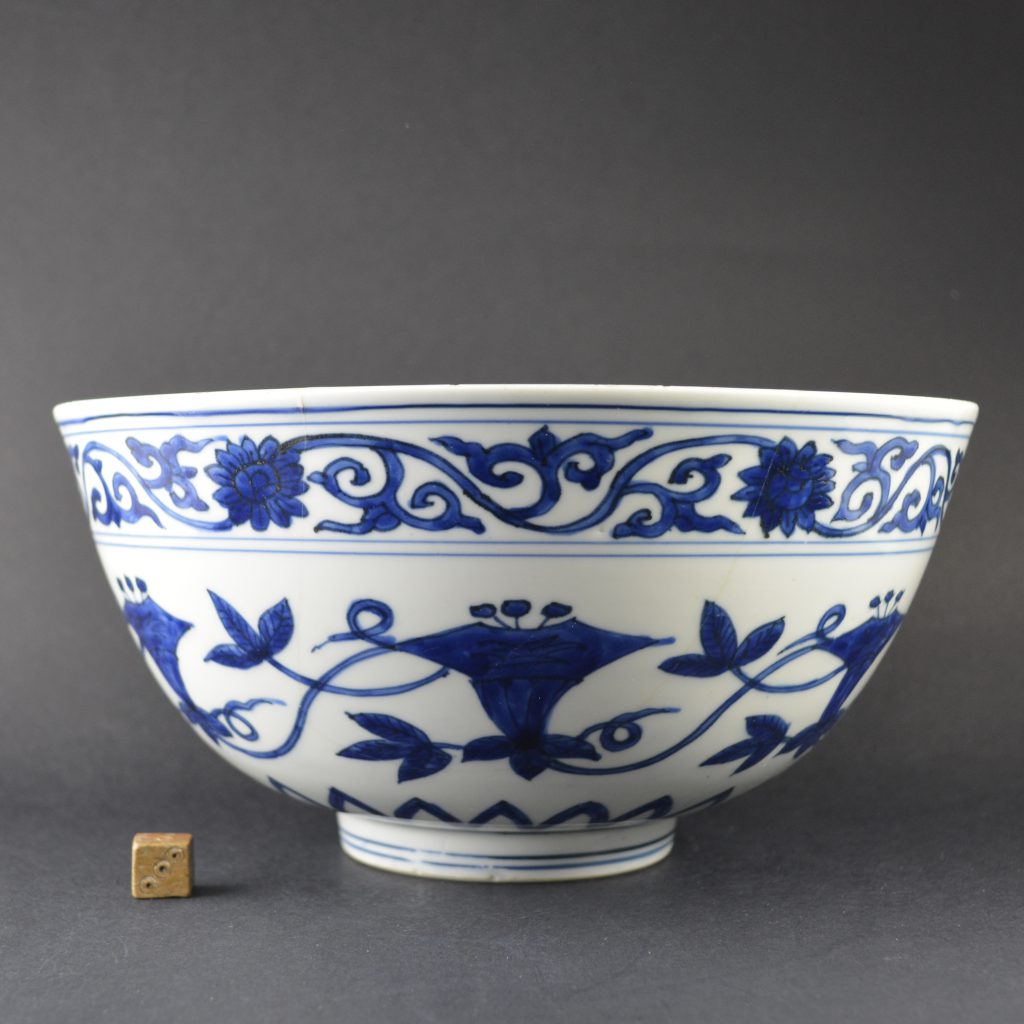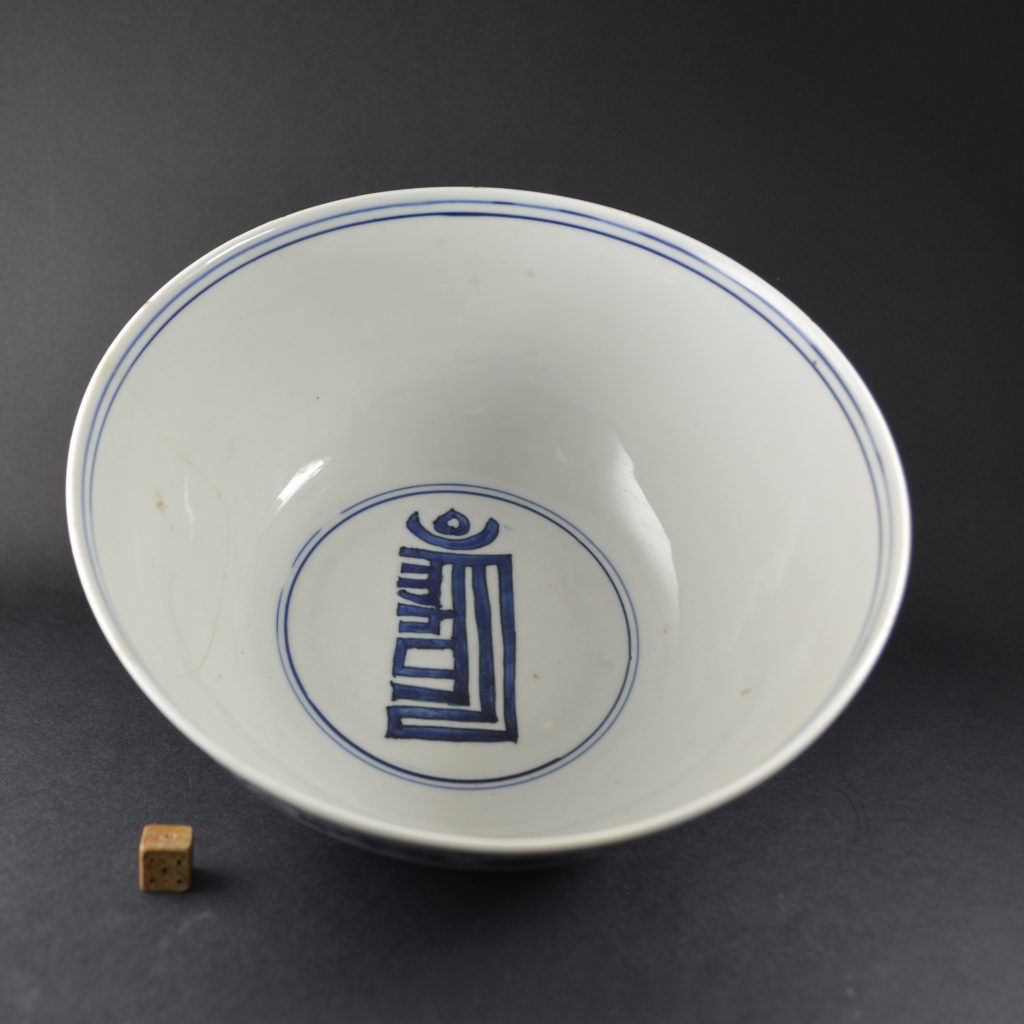
A Rare Imperial Wanli Porcelain Bowl, the Base with a Six Character Wanli Mark and of the Period 1573 – 1620
A Fine and Rare Imperial Ming Porcelain Bowl, Six Character Wanli Mark and of the Period 1573-1620. Painted in a later ‘Mohammedan Blue’ with Convolvulus (Morning Glory) arranged into a scrolling pattern around the middle of the bowl.
The striking cobalt blue used on this Imperial Ming bowl is sometimes called Lajvard Blue. Lajivard or Lajvardi is the Persian word for Lapis Lazuli, it refers only to the colour, as the stone was not used in the pigment. ‘Mohammedan Blue’ and ’Lajvard Blue’ fall in to the Sumatran Blue category, having properties of rich, dark blue, and containing black and silver specks where thickly applied. This very high-quality cobalt-oxide pigment is sometimes generally referred to as ‘Mohammedan Blue’ but this term should really only be used when referring to pigment from the reign of Hongwu (1368 – 1398). Some authors have made it easier, ‘Mohammedan Blue’ for the reign of Hongwu and ‘Later Mohammedan Blue’ for Lajvard and Sumatran Blue, in other words later cobalt pigments. None of the names define the country of origin, as the cobalt-oxide came from numerous places such as India, Persia and countries within the Arab world.
SALE PENDING
- Condition
- Repaired : there is a large ‘U’ shaped section restuck, a minute chip to the rim.
- Size
- Diameter : 20.3 cm (8 inches) Height : 10.8 cm (4 1/3 inches)
- Provenance
- Purchased in an antique shop in Rotterdam in the early 1990s. Robert McPherson Antiques. The John Drew Collection of Chinese and Japanese Ceramics.
- Stock number
- 25125
Information
Wanli Emperor
Wanli was born on the 4th of September 1563 and died on the 18th of August 1620, his personal name was Zhu Yijun. He was the 14th emperor of the Ming Dynasty. "Wanli", his reign name literally means "ten thousand calendars". He was the third son of the Longqing Emperor. His reign of 48 years (1572-1620) was the longest among all the Ming dynasty emperors and it witnessed the steady decline of the dynasty.

The John Drew Collection of Chinese and Japanese Ceramics :
John Drew was born in 1933 in Tideswell, Derbyshire, where his father was curate. The family moved to Norfolk whilst he was still a baby and his father became the rector of the parish of Intwood and Keswick. He was educated at Sedbergh School and after National Service in the R.A.F. being taught Russian, he went to Queens College, Oxford to read Greats (Classics). He spent nearly all his working life in various African countries as an archivist, moving to a post at Cape Town University in 1978. He remained in Cape Town after his retirement until his death in 2006. He had a great love of the English countryside (but not the climate) and this is shown in many of the pieces he collected. His taste was varied and ranged from Neolithic right through to the 18th Century. When we sent photograph to his home in Cape Town of pieces we thought he might be interested in, he would write long funny well observed letters back, wanting to add many of the items to his growing collection. Over the years we got to know him better and better, and during the last few years it was very rare for him to not want all the pieces we offered him. We knew his taste, even though his taste was so varied. This was in no small part because he had a very good eye and it was a pleasure finding things that interested him, because they were also very interesting to us. He never got to put his collection on display, something he hoped to do while on retirement in England, so it is with a mixture of pleasure and sadness that we offer these pieces from his collection. Each piece has a John Drew collection label, so when the collection is split up there will be some lasting record of the love and hard work he put into his two decades of collecting.















